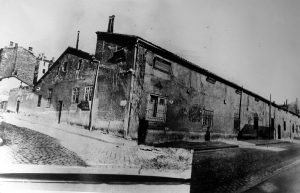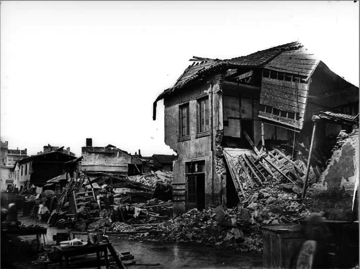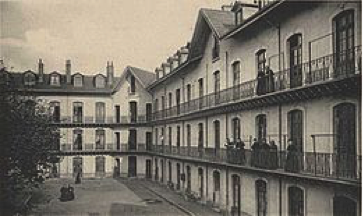History of the Prado
The work of the Prado
Father Chevrier loved the poor so much, and he loved Christ and his Gospel so much, that he was constantly driven by the conviction that "... the poor have the right to live their lives as they do". the poor have a right to the Gospel, to the whole Gospel" .
He believes that young people, who start work at the age of 8 in the glassworks, vitriol factories and other factories of Lyon and who find themselves at the age of 12 or 15 without knowing how to read and without having attended catechism classes, are capable of experiencing great joy in knowing Christ.
In his attempts to translate what he discovered.
He focuses on taking the catechism the children: many of them have been working since the age of 8 or 9 and have never been to school or Sunday school.
But he soon realised that they were being left behind, misunderstood and badly treated in a city that was made for the poor. He wanted them to feel at home, welcomed, respected, listened to and loved: it was in this climate that he intended to introduce them to Christ and his message.
The Prado,
A ballroom that becomes "the work of first communion
He felt that they would have to find "a place of their own", otherwise it would be impossible. But he hesitated; he had no desire to put a house on his back... Finally, having become certain that God was calling him in this direction, he made up his mind. And so he founded the Work of First Communion at Prado in 1860.
In the faubourg a ballroom where a thousand people could dance to their heart's content, which was called "Le Prado". One day, Father Chevrier saw a sign saying "for rent or for sale". He moved in with "his children". He kept them for six months and took them on completely, then he took on a new "series" for six months... and so on.
They are between twelve and eighteen years old. It's a "motley little world" that hasn't been easy, and they've already learnt a lot from the "school of the street" and the workshops. Some parents send their children because they are delinquents, while others ask Fr Chevrier to take them from prison to Prado. One witness said: " I often saw tall young men aged between 16 and 20 preparing to make their First Communion. Some of them had been employed as acrobats, boxers, oakum eaters and second-hand negroes. So the recreations were quite successful repetitions of the funfairs." .
He wanted to teach them and help them discover Christ in a warm atmosphere of trust and simplicity. Surprising transformations were taking place in them.

A tribute to the Curé d'Ars - whom he had met on two occasions
"Love of God and of our neighbour is the principle and the life-giving sap of everything, which must produce everything in us. Better charity without an exterior than an exterior without charity. Better disorder with love than order without love. This is what the Curé d'Ars expressed in a rather funny way when, speaking of the little girls of his Providence who were led according to these principles, since his daughter Catherine knew nothing of disciplinary methods, and speaking of this way of life and comparing it to the new way that was being introduced into his Providence, when once he had been forced to leave the helm to others, more skilful according to the world, he said that he liked his little bourdifaille of yesteryear". (VD, 223).

Le Prado: one name, two stories
 Lhe practical translation of the spiritual intuition received on Christmas night 1856 by Father Antoine Chevrier has undergone an evolution, on the part of the generations that have succeeded the Founding Father. How can we analyse the historical development of the work of the First Communion, which from the outset was strongly marked by the pastoral urgency of evangelising the poor? How does what we see today as the "educational work of Prado" still conform to the true intuition of its Founder? What does referring to this origin mean today for the Association of the Priests of Prado and their mission to evangelise the poor? To all these questions, we will try to offer some food for thought, so that we can better understand and situate ourselves in relation to the spirit of a grace that Father Chevrier received and that the Association of the Priests of Prado has received.Église confirmed and entrusted to the spiritual family of Prado.
Lhe practical translation of the spiritual intuition received on Christmas night 1856 by Father Antoine Chevrier has undergone an evolution, on the part of the generations that have succeeded the Founding Father. How can we analyse the historical development of the work of the First Communion, which from the outset was strongly marked by the pastoral urgency of evangelising the poor? How does what we see today as the "educational work of Prado" still conform to the true intuition of its Founder? What does referring to this origin mean today for the Association of the Priests of Prado and their mission to evangelise the poor? To all these questions, we will try to offer some food for thought, so that we can better understand and situate ourselves in relation to the spirit of a grace that Father Chevrier received and that the Association of the Priests of Prado has received.Église confirmed and entrusted to the spiritual family of Prado.
The creation of the "General Community
In 1954, Prado, which brought together priests from various French dioceses, asked the Holy See to recognise it as a Secular Institute of pontifical right. Its Constitutions provided for the existence of a "general community", taking over from the former "corps franc", its members being incardinated into the Institute and therefore dependent first and foremost on the Superior General of Prado, hence the name "general community", the membership of the other members of the Institute being primarily diocesan. The Constitutions of 1954 having been provisionally approved in February 1957, from that date the Superior General of Prado was able to incardinate into the Institute and call to Holy Orders.
Among the members of the former "corps franc", some opted for the status quo; others asked to be incardinated in the diocese where they were; many moved to the General Community.
Read more... The General Communityextract from a text written by Yves Musset.


